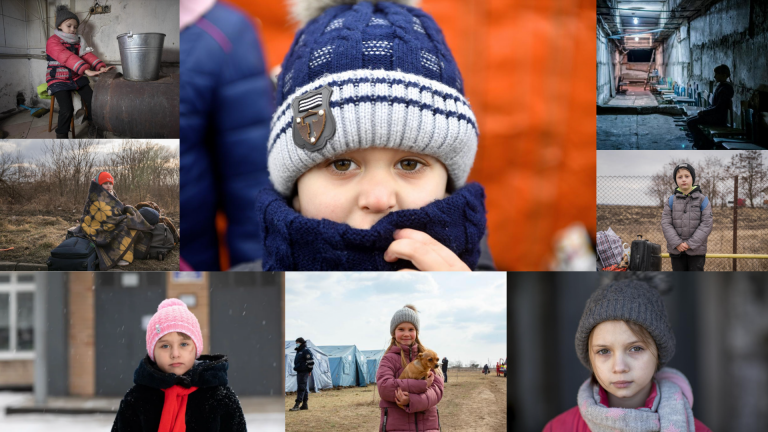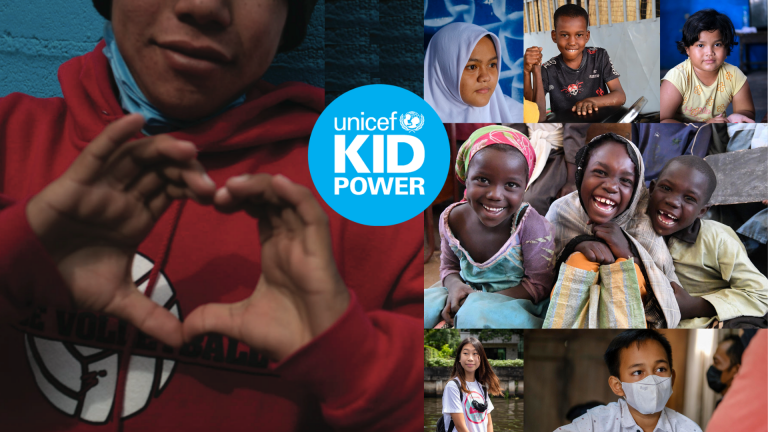When an escalating conflict like the current situation in Ukraine makes the headlines, it can cause feelings of fear, sadness, anger, and anxiety both at home and in the classroom. Students look to trusted adults for a sense of safety and security – even more so in times of crisis — which is why we’re sharing some important tips for talking to your students about the current conflict (although these tips are relevant to any conflict).
NOTE: Before you begin a class discussion about the situation in Ukraine, check out our blog post on teaching sensitive topics to your students. Your class may include students who are refugees or whose families have experienced political or civil unrest first-hand, and you’ll want to be as sensitive as possible.
1. Find out what your students know, how they feel, and validate their feelings.
Choose a time and place when you can bring the conflict up naturally—like morning meeting or a designated discussion time when your students are more likely to feel comfortable talking freely and when you have time to do the topic justice. Try to avoid the end of the school day or right before a break/transition such as lunch, recess, or special activities, when students’ minds are elsewhere.
A good starting point is to ask your class what they know about the conflict and how it makes them feel. Some students might not know much about what’s happening and may not be interested in talking about it, and that’s okay—don’t pressure them to participate.
Others might be communicating their worry silently, through body language. Give these students a chance to engage more privately through a writing exercise or a one-on-one discussion with you or another trusted teacher/staff member. Younger students and those with limited language skills might benefit from drawing pictures, making a collage using images from a magazine, creating a drag-and-drop digital storyboard, or dramatic role play with puppets or action figures. Remember that words are not the only way to communicate, especially for younger kids.
Your students may be getting their information from the news, social media, family, friends, or maybe even at school (a reminder to be mindful of conversations with other teachers in the lounge or other common areas that student could overhear). Since students can discover the news in many ways, it’s important to check in on what they’re seeing and hearing.
A constant stream of upsetting images and alarming headlines can make it feel like the crisis is all around us. Younger students and those with cognitive developmental challenges may not distinguish between images on screen and their own personal reality and may believe they’re in immediate danger, even if the conflict is happening far away. Older kids may have seen worrying things on social media and be afraid of how events might escalate. This is an opportunity to reassure students and potentially correct any inaccurate information they may have heard.
It’s important not to minimize or dismiss your students’ concerns. If a student asks a question that might seem extreme to you, such as “Are we all going to die?”, reassure them that is not going to happen, but also try to find out what they have heard, where they heard it, and why they are worried about that happening. If you can understand where the worry is coming from, you are more likely to be able to reassure them.
Acknowledge their feelings and assure them that whatever they are feeling is natural. Show that you’re listening by giving them your full attention and remind them that they can talk to you or another trusted adult whenever they would like.
2. Keep it calm and age appropriate.
Your students have a right to know what’s going on in the world, but adults also have a responsibility to keep them safe from distress. You know your students: use age-appropriate language to explain what’s happening, watch their reactions, and be sensitive to their level of anxiety.
It’s normal if you feel sad or worried about what’s happening, as well. But keep in mind that kids take their emotional cues from adults, so try not to overshare any fears with your students. Speak calmly and be mindful of your body language, such as facial expressions.
Also, carefully consider whether this should be a whole-group or small-group discussion. This may depend on the backgrounds of your students and even the mood in your classroom on the day of the discussion.
As much as you can, reassure your class that they are safe from any danger. Remind them that many people are working hard around the world to stop the conflict and find peace.
Use language that is both age-appropriate and takes student anxiety levels into consideration. Start with simple, low-risk language and watch their reactions. Then, decide if you should change your language gradually.
For example, don’t talk about “humanitarian access” unless you’re certain your entire class knows what “humanitarian” means. Most children can understand “access for people who need help”. For younger children or those with lower cognitive abilities, say “safe spaces” instead of “protection of civilian infrastructure”.
And remember, words matter—they can incite more anxiety than you intend. When talking to children, you may decide to steer clear of the word “war” in favor of “increasing conflict”.
3. Focus on the positive.
While you want to explain or clarify what’s happening in Ukraine, try not to provide too much detail, especially to younger students. Answer your students’ questions clearly, remembering that it’s okay to not have the answer to every question. You can say that you need to look up the answer or use it as an opportunity for older students to find the answers together, using the websites of reputable news organizations or international organizations like UNICEF and the UN.
Then, turn the conversation away from the specifics of the conflict and toward hope and positivity. Focus on the incredible strength of the human spirit of, and the compassion being shown to, the people involved in the conflict. Highlight the everyday heroes making a difference for families in Ukraine. To give students a sense of empowerment, as a class, brainstorm solutions for ending the crisis.
4. Focus on the helpers.
It’s comforting for students to know that people are helping families in Ukraine with acts of courage and kindness. Share these positive stories with your class. Discuss everyday heroes helping each other on the ground, the young people calling for peace, the first responders there assisting people, and organizations such as UNICEF that are on site before, during, and after humanitarian emergencies to bring lifesaving help and hope to children and families. Specifically, you can share that in Ukraine, UNICEF is trucking safe water to conflict-affected areas and providing healthcare; health, hygiene, and emergency education supplies; and protection and psychosocial care for children.
It can feel very empowering for your students to participate in positive action. Perhaps they could draw a poster or write a poem for peace. Remind your students that they are helping kids in need around the world receive lifesaving support every time their class completes a UNICEF Kid Power Up video. (If you haven’t signed up for the free UNICEF Kid Power program—that connects your students’ everyday actions with real-world impact for children around the world and for local causes that kids care about—do that today.)
The sense of doing something, no matter how small, can often bring great comfort, providing students with a sense of agency, control, and purpose that redirects feelings of anxiety and worry into feelings of hope and productiveness.
5. Spread compassion, not stigma.
Remind your students that conflict can often bring with it prejudice and discrimination, whether against a people or country. When talking to your class, avoid labels like “bad people” or “evil” and instead use it as an opportunity to encourage compassion, such as for the families forced to flee their homes.
Even if a conflict is happening in a distant country, it can fuel discrimination on your doorstep. Check that your students are not experiencing or contributing to bullying. If they have been called names or been bullied, encourage them to tell you, a parent, or another trusted adult.
Remind your class that everyone deserves to be safe at school and in society. Bullying and discrimination is always wrong, and we should each do our part to spread kindness and support each other.
6. Close conversations with care.
As you end your classroom conversation, it’s important to make sure that you are not leaving your students in a state of distress. Try to assess their level of anxiety by watching their body language, considering whether they’re using their usual tone of voice, and watching their breathing. Reinforce the messages about hope, courage, the global support Ukraine is seeing, and the everyday heroes that are there to help.
Remind them that you care and that you’re there to listen and support them whenever they’re feeling worried.
>> Read: How to recognize signs of distress in children
7. Continue to check in.
As news of the conflict continues, you should continue to check in with your class to see how they’re doing. How are they feeling? Do they have any new questions or things they would like to talk about with you?
If a student seems worried or anxious about what’s happening, keep an eye out for any changes in how they behave, such as complaining of stomachaches, headaches, nightmares or difficulties sleeping. Younger children have different reactions to adverse events, and some signs of distress may not be as obvious. They may be clingier than usual, while older students might exhibit intense grief or anger. Many of these reactions only last for a short time and are normal reactions to stressful events. If these reactions last for a prolonged period of time, you should reach out to parents and refer the student to the school therapist, psychologist, or nurse for mental health support.
8. Provide stress reducing activities.
There are several ways to reduce your students’ stress levels. You might read a soothing poem, listen to quiet music with heads down, or try belly breathing together:
- Take 5 deep breaths. Then, spend 5 seconds breathing in and 5 seconds breathing out, breathing in through your nose and out through your mouth each time.
- Explain that when students inhale, they are blowing up their tummies softly like balloons, and when they exhale, the air is going slowly out of the balloons again.
There are also several UNICEF Kid Power yoga and meditation videos designed to calm and quiet student minds while relaxing their bodies – a welcome change of pace after discussing a difficult topic. Choose from:
Younger Students
- My Way: empower students to stretch and strengthen their bodies with basic yoga moves.
- Relax & Explore: Animal Nature Walk: reset students’ minds with this simulated nature walk with animal yoga poses.
Older Students
- Falling: experience the feeling of free floating in the air, with a skydiving-themed yoga routine.
- Mercy: help students balance themselves with yoga filled with unique one-legged poses.
9. Team up with parents.
Reach out to your students’ parents and caregivers, notify them of any concerns about their children, and ask them to let you know if they have seen any concerning behaviors at home. Also suggest the resources below (and/or that they sign up for a parent account with UNICEF Kid Power):
>> Read: How to talk to your children about conflict and war
>> Read: How to recognize signs of distress in children
>> Read: Activities to reduce stress and support your and your child’s well-being
10. Take care of yourself.
You’re a stronger support to your students when you’re taking care of yourself. If you’re feeling anxious or upset, take time for yourself: reach out to family, friends and trusted colleagues for support. Be mindful of how you’re consuming news: try identifying key times during the day to check in on what is happening rather than constantly being online. As much as you are able, make some time to do things that help you relax and recuperate. Remember, your class will pick up on your own emotional response to the news, so it helps them to know that you are calm and in control.






